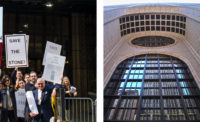Light-filled contemporary architecture and leading-edge medical care are not usually associated with rural health care facilities. Clinics serving rural populations are more likely to be bland modular buildings that competently provide the basics at low cost but offer little in the way of vibrant, nurturing spaces for patients and staff. Which prompts the question: Do the economics of health care delivery necessitate this cookie-cutter, one-set-of-options-fits-all approach?
Not always, say those responsible for the 14,300-square-foot UW Cancer Center Johnson Creek, in Johnson Creek, Wisconsin, a quiet community located between Madison and Milwaukee on I-94. The owners—UW Health, Fort Health Care, and the nearby Watertown Memorial Hospital—achieved something far greater by joining forces (and resources) and asking the Chicago office of OWP/P to design a signature building, one that would elevate the center’s profile and, most important, foster the best possible experience for patients in very difficult circumstances. The result uses natural light, visual connections to the landscape, and form to create that gentle uplift.
OWP/P project director Jim Mladucky, AIA, credits UW Cancer Center director Lynda Persico and her colleagues with having a “very clear vision of how they wanted the building to function, how the flow of patients was going to work, and how staff would interact with patients.” To offset the intimidation the elderly and the very ill might feel in a high-tech, clinical environment, the center’s state-of-the-art diagnostic and treatment areas—including a linear accelerator, a device for high-energy radiation therapy that must be housed in an ultra-thick concrete vault—needed to be exceedingly easy to find and navigate. And while the clients wanted that inviting, noninstitutional feel to extend to all aspects of the building, they also sought a bold design that would attract and retain top talent and reflect the 21st-century medical care inside.
The project’s defining feature, an asymmetrical butterfly roof that dramatically expresses the building’s steel frame at both ends, is both a practical and metaphorical response to the program. The “wing” at the east end of the building rises to create a clerestory above the entrance, lobby/check-in desk, and waiting area. The other, much-longer roof deck lifts at a shallower angle to accommodate the height of the linear accelerator vault and hide the mechanical systems in a plenum along the north (front) side of the building and, on the south side, bring light into the center’s wide central corridor through another clerestory. For patients accustomed to radiation and oncology departments in institutional basement settings, the interior light and volume afforded by the roof angles are nothing short of a small miracle.
PeopleOwner: Architect: Personnel in architect's firm who should receive special credit: Jim Mladucky, AIA, ACHA, CCS - Project Director Troy Hoggard, AIA, LEED AP - Project Designer Scott Nelson, AIA, ACHA, MBA - Programmer Jennifer Knapp – Interior Design Mike Yoshimura, AIA - Technical Coordinator Elizabeth Werner – Project Architect Interior designer: OWP/P Beth Smith - Interior Designer Elizabeth Kolzow - Intern Architect Scott Lay - Project Architect Engineer(s): Fred Groth is designated as Principal – Structural Mechanical engineer: Electrical engineer: General contractor: CG Schmidt Construction (Bruce Danek, Rod Marron, and Dale Smith) Photographer(s): James Steinkamp © Steinkamp Ballogg Photography |
ProductsPrincipal interior construction materials by manufacturer: Paint: Sherman Williams Laminate: Pionite Masonry: Endicott Clay Products Flooring: Vinyl Tile: Armstrong Rubber Base: Johnsonite Ceiling Tile: Armstrong Linoleum Flooring: Forbo Carpet/carpet tile: Interface Carpet fiber: Interface Carpet backing: Interface-Glasbac Tile Performance Broadloom Ceiling: Armstrong Cirrus Lighting: General recessed down lighting: Capri, Omega Revelation Decorative recessed down lighting: Lucifer Decorative wall sconces: Visa, Scott Architectural Lighting Decorative pendants: Scott Architectural Lighting, Pathway Serio Direct/Indirect Recessed Troffers: Focal Point Treatment Room Direct/Indirect Lighting: Ledalite Pure FX Egress Lighting: Concealite, Lithonia Doors: Wood Veneers (Eggers) Door hardware: (Hardware in general – LaForce) Glass: Kawneer FG Series/Kawneer Encore Series Window frames: (Exterior only) Kawneer Window treatments: Creative Energy Principal Furninshing by Manufacturer: Casegoods: Knoll Patient overbed tables: Softcare Patient room lighting: See lighting above Lounge seating: Cafeteria/dining seating: Upholstery: Cafeteria/dining/conference tables: Haworth Coffee and side tables: Brandrud Files and shelving: Knoll Building systems by manufacturer Fire safety: Security: Key Card Readers – Keri Systems, Inc. Building management system:
|
























